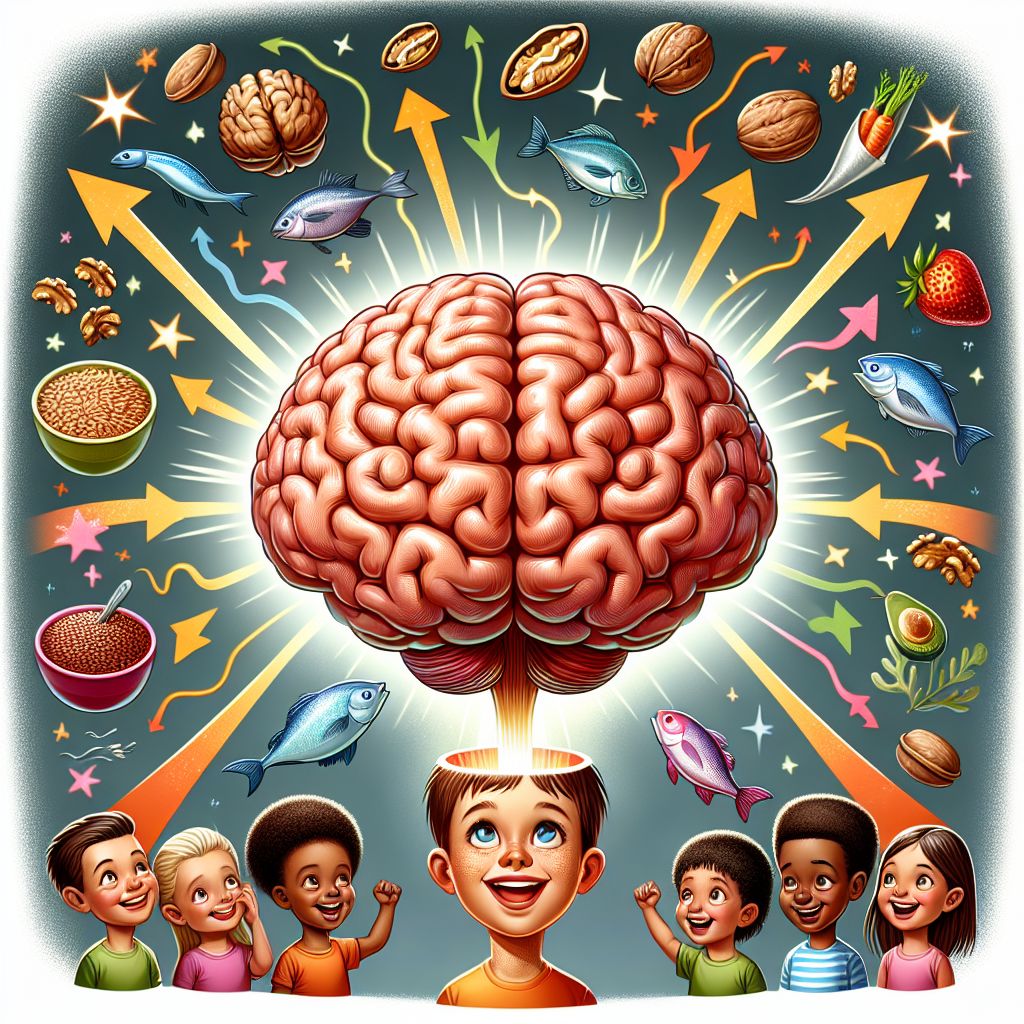-
Omega-3 fatty acids are crucial for brain development and function, particularly ALA.
-
Including omega-3-rich foods like seafood, nuts, and seeds in your child’s diet can enhance cognitive abilities.
-
Creative recipes and meal ideas can help integrate these nutrients into a picky eater’s diet.
-
While supplements are available, natural food sources of omega-3s are generally preferred.
-
Understanding the balance of omega-3 and omega-6 fats is important for optimal brain health.

The Role of Omega-3 Fatty Acids in Brain Health
When it comes to boosting your child’s intelligence, the power of omega-3 fatty acids cannot be overstated. These fats are not just any ordinary nutrients; they’re essential for the healthy development of the brain. Think of them as the building blocks that help construct a strong foundation for cognitive function, learning, and memory.
Understanding Omega-3s and Their Types
There are three most common types of omega-3 fatty acids: ALA (alpha-linolenic acid), DHA (docosahexaenoic acid), and EPA (eicosapentaenoic acid). While all three are important, ALA is the unsung hero for children’s brain health. It’s found in plant sources and is the precursor to DHA and EPA, which are more readily available in fish and other seafood.
The Significance of ALA for Brain Development
ALA is especially crucial during the early stages of life. It plays a pivotal role in brain development and function, laying the groundwork for your child’s cognitive growth. Because the body can’t produce ALA on its own, it’s important to include ALA-rich foods in your child’s diet.
How Omega-3 Fatty Acids Influence Cognitive Function
Omega-3 fatty acids, particularly DHA, are involved in various brain processes, including the formation of cell membranes and anti-inflammatory pathways. They also play a role in neuron function and signaling, which is the brain’s way of communicating. This is why a diet rich in omega-3s is often linked to improved learning abilities and a lower risk of developmental delays.
Omega-3s: The Building Blocks of a Smart Brain
Just as a house needs bricks, a child’s brain needs omega-3s to develop properly. These fatty acids are vital for creating the neural connections that underpin intelligence. Without enough omega-3s, children may not reach their full cognitive potential.
Integrating Omega-3s into Your Child’s Diet
So, how do you make sure your child is getting enough omega-3s? It’s simpler than you might think. Incorporate foods like flaxseeds, chia seeds, and walnuts into their meals. For DHA and EPA, fatty fish such as salmon and sardines are excellent choices. But remember, the key is consistency. Make these foods a regular part of their diet for the best results.
Here are a few easy tips to get started:
-
Add ground flaxseed or chia seeds to smoothies, oatmeal, or yogurt.
-
Make fish a staple in your weekly meal planning.
-
Use walnut oil in salad dressings or as a dip for bread.
It’s all about making omega-3s a natural part of what they eat every day.
Evaluating the Impact of Omega-3s on Memory and Learning
Research has consistently shown that children who consume more omega-3 fatty acids perform better in areas of memory, language, and cognitive processing. It’s like giving your child’s brain the fuel it needs to power through learning and remembering new information.
Omega-3 Fatty Acids in Pregnancy and Early Childhood
Omega-3 intake isn’t just crucial for children; it’s also important for expectant mothers. During pregnancy, omega-3s support fetal brain development. This continues post-birth, as breast milk is a natural source of DHA, essential for newborn brain growth.
But what if you’re not breastfeeding or want to ensure your child continues to get these nutrients as they grow? Here’s what you can do:
-
Introduce pureed fish like salmon into your baby’s diet once they start on solids.
-
For older children, offer omega-3-rich snacks like walnuts or homemade fish sticks.
It’s about creating a diet that supports brain development at every stage of your child’s growth.
Finding Fortified Foods Enriched with Omega-3s
Let’s face it, not all kids are thrilled about eating fish or nuts. That’s where fortified foods come into play. These are foods that have had nutrients added to them, making it easier to get those vital omega-3s into your child’s diet. Look for omega-3-enriched eggs, milk, yogurt, and even some breads and cereals. Just check the labels to make sure they’re truly fortified with omega-3s.
For example, some orange juices now come fortified with omega-3s. A glass of this in the morning can start your child’s day with a boost of brain power.
Remember, while fortified foods are a helpful supplement, they shouldn’t be the sole source of omega-3s in your child’s diet. And ideally they should not be used at al. Natural sources are always best.
Incorporating Omega-3s into a Child’s Daily Menu
Consistency is key when it comes to nutrition. Make omega-3s a staple by including them in meals throughout the day. Breakfast might include omega-3 enriched eggs or chia seed pudding. For lunch, a sandwich with omega-3 fortified bread, and dinner could feature grilled salmon or a walnut-crusted chicken.
Snacks are also an opportunity to sneak in some omega-3s. A smoothie with flaxseed oil or a handful of walnuts are great options. By spreading out the intake, you’re ensuring a steady supply of these brain-boosting fats throughout the day.
And don’t forget about hydration! While water is the best choice, occasionally incorporating a fortified orange juice or milk can add an extra omega-3 punch.
A simple snack like a homemade trail mix with walnuts, dried fruit, and dark chocolate can provide a tasty and nutritious omega-3 boost.
Creative Omega-3 Infused Recipes for Picky Eaters
Getting creative in the kitchen can turn omega-3 rich foods into favorites for even the pickiest of eaters. Try making fish tacos with a slaw that includes chia seeds, or bake some flaxseed meal into muffins and pancakes. Making these foods fun and flavorful can change the way your child thinks about healthy eating.
Here’s a simple recipe to try:
-
Salmon fish fingers with a yogurt and dill dip
-
Blend chia seeds into a berry smoothie
-
Bake walnut and banana bread as a treat
Omega-3 Supplements: Are They Necessary?
While supplements can be a convenient way to increase omega-3 intake, they’re not a magic pill. The goal should be to get nutrients from food first. Supplements might be considered if dietary restrictions, allergies, or other factors limit the inclusion of omega-3-rich foods. If you’re considering supplements, it’s best to consult with a healthcare provider to determine what’s right for your child.
Balancing Omega-3 Intake with Other Essential Nutrients
It’s not just about omega-3s. A balanced diet that includes a variety of nutrients is essential for overall health and cognitive development. This means pairing omega-3-rich foods with fruits, vegetables, whole grains, and lean proteins. Also, be mindful of the balance between omega-3 and omega-6 fats, as too much omega-6 can promote inflammation and counteract the benefits of omega-3s.
Most importantly, encourage a healthy eating pattern that your child can follow for life. This is the true key to supporting their cognitive development and overall well-being.
Understanding the Nutritional Science Behind Omega-3s
When we delve into the science, it’s clear why omega-3s are so beneficial for brain health. They contribute to the fluidity of cell membranes, facilitate communication between brain cells, and have anti-inflammatory effects. All these factors play a role in learning and memory.
Exploring the Brain Benefits of DHA and EPA
DHA and EPA, found primarily in fish, are directly involved in brain health. DHA is a major structural component of the brain, while EPA has potent anti-inflammatory properties that protect the brain against damage and aging.
Scientific Studies on Omega-3s and Cognitive Performance—why ALA is more important than DHA and EPA
While DHA and EPA often steal the spotlight, ALA is equally important. It’s a precursor to the other omega-3s, meaning the body can convert it into DHA and EPA. ALA also has its own role in brain health and can be converted into energy for brain cells. Moreover, ALA is easier to include in the diet through plant-based sources, making it accessible for everyone.
Addressing Myths and Facts About Fats and Brain Development
There’s a common misconception that all fats are bad. However, the truth is that healthy fats like omega-3s are vital for brain development. The key is to focus on the right types of fats and ensure they are consumed in appropriate amounts.
Navigating Dietary Recommendations for Optimal Brain Health
So, how much omega-3 does your child need? While there’s no one-size-fits-all answer, a good rule of thumb is to include a source of omega-3s at each meal. This ensures that your child gets a steady supply of these essential fats throughout the day.
Dietary guidelines suggest that children should eat fish 1-2 times per week and include plant-based sources of ALA daily. As for the balance of omega-6 to omega-3 fats, aim for a ratio closer to 1:1 or lower.
By following these guidelines and making omega-3s a regular part of your child’s diet, you’re setting them up for a lifetime of learning and cognitive success.
How Much Omega-3 Is Sufficient for a Growing Child?
The exact amount of omega-3s needed can vary based on age, weight, and health status. Generally, children aged 1-3 years need about 0.7 grams of ALA per day, while those aged 4-8 years need 0.9 grams. But who is going to measure that? Easier to figure, give half a tablespoon in a drink for the 2-3 year old and double that for the 4-8 year old group. For EPA and DHA, a combined intake of at least 250-500 mg per day is recommended for children and adults.
Keeping these numbers in mind, you can plan your child’s meals and snacks to meet their omega-3 needs and support their developing brain. By doing so, you’re not just making them smarter; you’re investing in their future health and happiness.
Omega-3 fatty acids are not just another health trend; they are fundamental to our children’s brain development and cognitive function. The basic ALA is called an “essential fatty acid”— that means first of all it is critical to the body, second that your body can’t make it from something else and third, that means you need to give an ALA omega 3 food to your child. Daily. As a parent, it’s essential to understand how these fats work and the best ways to incorporate them into your child’s diet. But most importantly, you need practical, everyday strategies to make sure your child is getting these vital nutrients. Let’s dive into the details and give you the tools you need to boost your child’s brainpower.
Firstly, let’s talk about why omega-3s are so important. These fatty acids are key components of the cell membranes in the brain, playing a crucial role in cell signaling and brain function. But not all omega-3s are created equal. ALA (alpha-linolenic acid), found in plant sources like flaxseeds and walnuts, is essential for children as it’s a precursor to the other omega-3s, DHA and EPA, which are more commonly found in fish. But more importantly it is part of the doors and windows of the cell walls on the brain cells, letting in oxygen and nutrients and helping toxins to be removed.
Now, you might be thinking, “How do I get my child to eat these foods regularly?” It’s simpler than you might think. You can sprinkle ground flaxseed on their cereal, add chia seeds to their yogurt, or offer them walnut halves as a snack. When it comes to fish, try introducing it in a fun way, like making homemade fish sticks or fish tacos. The goal is to make these foods a natural part of their diet, so they’re reaping the benefits of omega-3s every day. Create a smoothie with fruit and milk and flax seed.
And let’s not forget about fortified foods. Many products on the market are now enriched with omega-3s, making it even easier to ensure your child is getting enough. For example, some brands of milk, eggs, and even bread are fortified with these brain-boosting fats. Just be sure to read the labels to confirm that these foods contain added omega-3s.
For example, some brands of milk are fortified with DHA, which is a form of omega-3 fatty acid. By choosing these products, you can help support your child’s brain development even if they’re not a fan of fish.
As we move forward, it’s important to consider the specific needs of your child. Every child is different, and their dietary requirements for omega-3s can vary based on factors like age and overall health. But don’t worry; there are general guidelines you can follow to make sure they’re getting what they need.
Dietary Guidelines for Omega-3 Consumption in Different Age Groups
-
Infants (0-12 months): Breast milk is the ideal source of DHA for infants. If breastfeeding isn’t possible, choose formulas fortified with DHA.
-
Toddlers (1-3 years): Aim for 0.7 grams of ALA daily. Include small amounts of fish to introduce direct sources of DHA and EPA.
-
Children (4-8 years): Increase ALA intake to 0.9 grams daily. Continue offering fish regularly, aiming for 1-2 servings per week.
-
Older children and teenagers: Ensure a balanced diet with multiple sources of omega-3s, including both ALA and direct sources of DHA and EPA.
By tailoring omega-3 intake to your child’s age, you’re supporting their brain development at each crucial stage of growth.
Yet, while focusing on omega-3s is important, it’s equally essential to maintain a balance with omega-6 fatty acids. These fats are also necessary for health but in the right ratio to omega-3s. Too much omega-6 can lead to inflammation, which is detrimental to brain health and overall well-being. And worst of all, processed omega-6 in the common cooking oils and as an addative to most processed foods is very harmful to the child and a leading cause of obesity.
The Harmony of Fats: The Right Balance of Omega-6 to Omega-3
Striking the right balance between omega-6 and omega-3 fatty acids is a delicate dance. The typical Western diet tends to be heavy on omega-6s, found in many vegetable oils and processed foods. To counteract this, focus on reducing intake of these omega-6-rich foods while increasing omega-3s. Aiming for a dietary ratio of omega-6 to omega-3 closer to 1:1 or even lower can help promote better brain health and reduce inflammation.
FAQs on Omega-3 Fatty Acids and Child Intelligence
Parents often have questions about omega-3 fatty acids and their role in their child’s development. Let’s address some of the most common inquiries to clear up any confusion and provide you with the confidence to make informed decisions about your child’s nutrition.
What Are Omega-3 Fatty Acids and Why Are They Important?
Omega-3 fatty acids are a type of unsaturated fat that is essential for brain health and development. They’re called ‘essential’ because the body cannot produce them on its own; they must be obtained through diet. These fats are crucial for the formation of cell membranes in the brain, for neuron function, and for anti-inflammatory processes.
Can Omega-3 Supplements Replace Natural Food Sources?
While supplements can be a convenient way to boost omega-3 intake, they should not be the primary source. Whole foods offer a complex array of nutrients that work together to support health. If you’re considering a supplement for your child, it’s best to consult with a healthcare professional to discuss the appropriate type and dosage.
How Do Omega-3 Fatty Acids Affect Children’s Mood and Behavior?
Studies have shown that omega-3 fatty acids can have a positive impact on children’s mood and behavior. They may help reduce symptoms of ADHD, improve sleep quality, and even lessen anxiety. This is likely due to their role in brain function and neurotransmitter regulation.
Are There Any Risks Associated with High Intake of Omega-3s?
If you take your omega-3 in the form of ALA, the essential fat in the form of whole food source, you cannot get too much. Supplements with DHA and EPA could exceed healthy levels and I don’t recommend it.
It’s also important to be mindful of the source of omega-3s, especially fish, which can contain contaminants like mercury. Opt for low-mercury fish such as salmon, sardines, and trout, and limit high-mercury fish like shark, swordfish, and king mackerel.
How Can I Ensure My Child Is Getting Enough Omega-3s?
To ensure your child is getting enough omega-3s, focus on including a variety of omega-3-rich foods in their diet. This includes plant-based sources of ALA, such as flaxseeds, chia seeds, and walnuts, as well as DHA and EPA from fish. For picky eaters, try fortified foods or supplements like the Udo 3-6-9 supplement. Most importantly, create a balanced diet that includes these essential fats along with a wide range of other nutrients to support overall health and cognitive development.
Remember, the journey to a smarter, healthier child begins with what’s on their plate. By making omega-3s a regular part of their diet, you’re not just feeding their bodies; you’re nourishing their brains and setting them up for a lifetime of learning and success.
Stanley Lang, M.D. has been in active medical practice since 1978. He has been a family physician during these years with detailed experience in all age groups including delivering babies for several years. He has been a pioneer in developing models of wholistic health care that bring health to the whole person. He has particularly focussed on reversing Chronic Stress effects on the body. He is the creator of the Shalom Method for Wholistic Health, and he has created several online programs that allow patients to naturally self manage their problems including “The Natural Lyme disease Treatment Program”, the “Menopause Balancing Program”, “The Happy Healthy Child” program plus many others.



